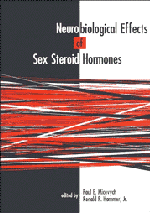Book contents
- Frontmatter
- Contents
- List of contributors
- Dedication
- Preface
- Acknowledgments
- Part I Sex steroid–responsive circuits regulating male and female reproductive behaviors
- Part II Sex steroid interactions with specific neurochemical circuits
- Part III Cellular and molecular mechanisms regulated by sex steroids
- 12 Neurosteroids and neuroactive steroids
- 13 Estrogen synthesis and secretion by the songbird brain
- 14 Neurobiological regulation of hormonal response by progestin and estrogen receptors
- 15 Molecular actions of steroid hormones and their possible relations to reproductive behaviors
- 16 Effects of sex steroids on the central nervous system detected by the study of Fos protein expression
- 17 Developmental interactions of estrogens with neurotrophins and their receptors
- 18 Sex steroid influences on cell–cell interactions in the magnocellular hypothalamoneurohypophyseal system
- Index
12 - Neurosteroids and neuroactive steroids
Published online by Cambridge University Press: 15 October 2009
- Frontmatter
- Contents
- List of contributors
- Dedication
- Preface
- Acknowledgments
- Part I Sex steroid–responsive circuits regulating male and female reproductive behaviors
- Part II Sex steroid interactions with specific neurochemical circuits
- Part III Cellular and molecular mechanisms regulated by sex steroids
- 12 Neurosteroids and neuroactive steroids
- 13 Estrogen synthesis and secretion by the songbird brain
- 14 Neurobiological regulation of hormonal response by progestin and estrogen receptors
- 15 Molecular actions of steroid hormones and their possible relations to reproductive behaviors
- 16 Effects of sex steroids on the central nervous system detected by the study of Fos protein expression
- 17 Developmental interactions of estrogens with neurotrophins and their receptors
- 18 Sex steroid influences on cell–cell interactions in the magnocellular hypothalamoneurohypophyseal system
- Index
Summary
Introduction
The relationships between steroid hormones and brain function have been envisioned mostly within the framework of endocrine mechanisms, as responses elicited by secretory products of steroidogenic endocrine glands, borne by the bloodstream, and exerting actions on the brain.
In fact, the brain is a target organ for steroid hormones. Intracellular receptors involved in the regulation of specific gene transcription have been identified in neuroendocrine structures, with each class of receptor having a unique distribution pattern in the complex anatomy of the brain (Fuxe et al. 1981; McEwen 1991a). Mechanisms involving nuclear receptors account for most steroid-induced feedback and many behavioral effects, for the regulation of the synthesis of several neurotransmitters, hormone-metabolizing enzymes, and hormone and neuromediator receptors, and for the organizational effects on neural circuitry that occur during development and persist into adulthood.
Local target tissue metabolism is an important factor in the mechanism of action of sex steroid hormones. Not only might such metabolism be involved in the regulation of intracellular hormone levels, but it might also provide an essential contribution to the cellular response. The brain is a site of extensive steroid metabolism. Aromatization and 5α-reduction represent major routes of androgen metabolism (Naftolin et al. 1975; Celotti et al. 1979; McLusky et al. 1984). The importance of these two pathways lies in the fact that they give rise to metabolites with considerable biological activity and thus are involved in the mechanism by which circulating androgens influence neuroendocrine function and behavior.
- Type
- Chapter
- Information
- Neurobiological Effects of Sex Steroid Hormones , pp. 281 - 296Publisher: Cambridge University PressPrint publication year: 1995
- 2
- Cited by



